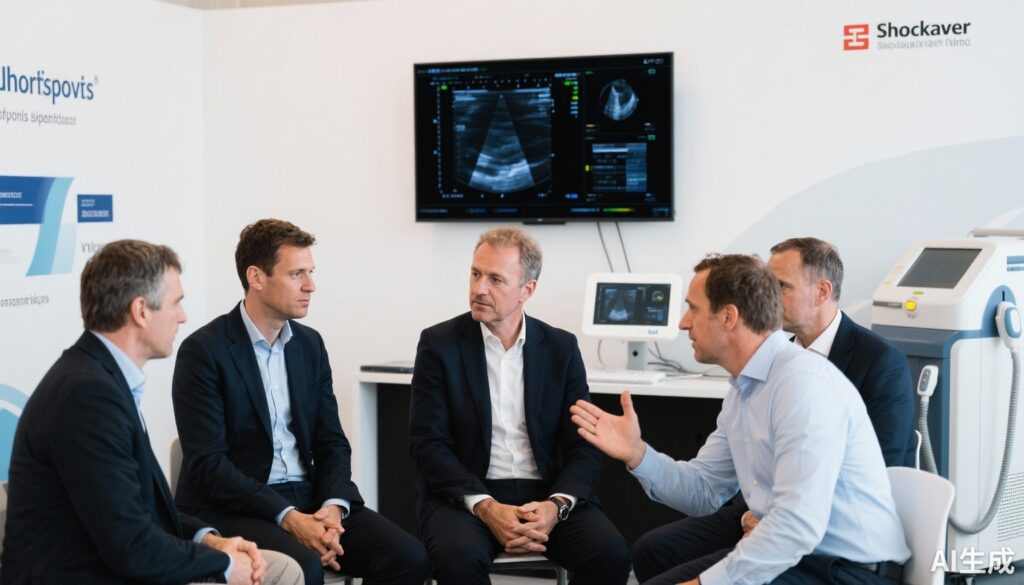Introduction and Context
Extracorporeal shockwave therapy (ESWT) — delivery of high-pressure acoustic pulses to tissue — has emerged over the past two decades as an adjunctive option for a range of musculoskeletal conditions commonly seen in sports medicine, including tendinopathies, plantar fasciopathy and selected bone pathologies. Heterogeneous devices, inconsistent reporting of treatment parameters and widely varying protocols in clinical trials have limited clinicians’ ability to translate the evidence into consistent practice.
To create practical, clinically useful guidance, an international steering committee convened 41 experienced clinicians and researchers from 13 countries and performed a modified three-round Delphi process, reporting consensus on terminology, indications, procedural considerations, contraindications and expected side effects of ESWT in sports medicine (Rhim et al., Br J Sports Med. 2025). This article summarizes the panel’s core recommendations, highlights what the panel could not agree on, and explains the implications for everyday care and future research.
Why this consensus matters now
– Uptake of ESWT has expanded, but trial heterogeneity (device types, energy, impulses, number/frequency of sessions) impairs evidence synthesis and clinical implementation.
– Clinicians need pragmatic guidance on when to use ESWT, what to document, and which patients are unsuitable.
– The Delphi panel aimed to translate collective expertise into consensus statements to improve standardization of practice and reporting.
New Guideline Highlights
Major takeaways for clinicians
– Clear terminology and device reporting are essential. The panel reached consensus that clinicians and researchers should explicitly state the type of shockwave (focused vs radial), device manufacturer and model, energy parameters and number of impulses in clinical records and publications.
– ESWT is supported as an adjunctive, non‑invasive option for selected sports-related tendinopathies and some bone pathologies, particularly when standard conservative measures have failed.
– Procedural recommendations were stronger for tendinopathy than for bone injuries; many technical aspects of ESWT in bone healing remain unresolved.
– Absolute contraindications and common side effects were identified and largely agreed upon.
Key clinical messages (short)
– Use standardized terminology and document device/parameter details.
– Consider ESWT after an adequate trial of conservative care (generally several weeks to months depending on pathology).
– Counsel patients about expected transient pain and local skin reactions; serious adverse events are uncommon.
– Avoid ESWT in absolute contraindications such as pregnancy, untreated infection and certain malignant conditions.
Updated Recommendations and Key Changes
What the Delphi adds to prior literature
– Standardization emphasis: The strongest new theme is the expert requirement to report ESWT device characteristics and treatment parameters systematically. This mirrors long-standing calls from methodologists and systematic reviewers for better reporting to allow pooling and reproducibility (Wang CJ. J Orthop Surg Res. 2012).
– Procedural clarity for tendinopathy: The panel achieved consensus on many practical procedural points for tendinopathy (see topic section).
– Ongoing uncertainty for bone pathology: Although panelists generally supported ESWT for selected bone conditions, many specific procedural aspects (optimal energy, dosing schedules) for bone healing did not reach consensus, highlighting a knowledge gap and a research priority.
How this differs from earlier guidance
– Earlier reviews and clinical summaries emphasized efficacy in particular pathologies (e.g., plantar heel pain, lateral elbow) but rarely specified a recommended minimum standard of reporting or reached international expert consensus on procedural best-practice. The Delphi study provides a structured set of consensus statements to standardize practice and reporting across centers.
Topic-by-Topic Recommendations
The Delphi panel produced consensus statements across multiple domains. Below we summarize the core, clinically actionable recommendations and note where consensus was not reached.
Terminology and documentation (consensus)
– Always specify:
– Shockwave type: focused ESWT vs radial pressure wave (radial ESWT).
– Device manufacturer and model.
– Key machine settings: energy or energy flux density (EFD) if available, frequency (Hz), number of pulses/impulses, and number of treatment sessions.
– Patient positioning, use of local anaesthesia (if any), and imaging guidance (ultrasound/radiograph) where applicable.
Indications (consensus)
– Tendinopathy: ESWT was supported as an adjunctive treatment for chronic tendinopathies that have not responded to an adequate trial of conservative care (loading programs, activity modification, analgesics). Common target conditions included: plantar fasciopathy, Achilles tendinopathy, patellar tendinopathy, and lateral elbow tendinopathy.
– Bone pathology: The panel supported the use of ESWT for certain bone-related conditions (for example, selected delayed unions, non-unions and stress-related bone injuries) but stressed that device- and protocol-specific details remain uncertain.
– ESWT was presented as an adjunct rather than a universal first-line therapy; patient selection remains important.
Procedural aspects — tendinopathy (consensus on many items)
– Imaging guidance: Ultrasound guidance or image localization was recommended when it improves targeting (for example, focal calcific deposits or deep tendon insertions).
– Periprocedural analgesia: Local anaesthesia can reduce patient discomfort but may blunt the therapeutic effect for certain protocols; the panel recommended judicious use and documentation.
– Combination therapy: ESWT is often combined with rehabilitation (structured loading/eccentric exercise programs); the panel agreed that ESWT should be integrated into a broader rehab plan rather than used in isolation.
– Documentation: Record number of sessions, pulses per session, energy settings, interval between sessions and patient-reported response.
Procedural aspects — bone pathology (no consensus on many technical points)
– Indication support: Panelists generally supported ESWT for some bone pathologies (e.g., delayed union, certain stress fractures) as a non-invasive option when surgery is undesirable or as a supplement to standard care.
– Technical uncertainty: Whereas consensus supported using ESWT for bone problems in principle, the panel did not reach agreement on optimal energy dosing, number of sessions, or pulse counts for specific bone pathologies. These areas were identified as high priorities for clinical trials.
Peri- and post-procedural considerations (consensus)
– Patient counseling: Patients should be informed about expected transient pain, local bruising or swelling and the low likelihood of serious complications.
– Activity modification: Minor activity modification may be advised short-term; integration with progressive rehabilitation is encouraged.
– Follow-up: Functional and pain outcomes should be assessed at baseline and at prespecified follow-up intervals (for example 6–12 weeks and beyond), with documentation of patient-reported outcomes.
Contraindications and safety (consensus)
– Absolute contraindications included: pregnancy, malignant or suspicious lesions at the treatment site, and untreated infections.
– Relative contraindications included: anticoagulation (risk–benefit assessment), significant neurological deficits in the treatment area, coagulation disorders and active dermatological conditions at the site.
– Side effects: Typical short-term adverse effects include transient pain during or after treatment, local erythema, skin petechiae or bruising. Serious adverse events were considered rare by the panel.
Reporting and research recommendations (consensus)
– Standardize reporting in clinical trials and practice: device type, energy/EFD, total pulses, pulses per site, frequency, number of sessions and interval between sessions.
– Prioritize clinical trials for bone pathologies to define optimal dosing and treatment schedules.
– Encourage uniform outcome measures (pain scales, validated function measures) to improve comparability of studies.
Expert Commentary and Insights
What the panel emphasized
– The strongest consensus centered on transparency and standardization. Experts repeatedly underscored that inconsistent reporting of devices and parameters has been a major barrier to interpreting ESWT literature.
– Many panelists framed ESWT as an evidence-based, minimally invasive adjunct rather than a panacea. They recommended careful patient selection and integration with exercise-based rehabilitation.
Controversies and unresolved questions
– Bone healing: There was widespread support for ESWT in selected bone conditions, but disagreement on technical parameters prevents firm procedural recommendations — a key area for future trials.
– Role of anaesthesia: The potential of local anaesthesia to reduce treatment efficacy remains debated; panelists advised individualizing its use and documenting it.
Panel perspectives on implementation
– Clinic readiness: Adoption requires available, validated devices, operator training and protocols to document parameters reliably.
– Regulatory and reimbursement considerations: Clinicians should be aware local payer policies and demonstrate appropriate documentation and rationale for ESWT use in individual patients.
Practical Implications
How to apply the recommendations in daily practice
– Before treatment: Confirm an appropriate indication (failed adequate conservative care), document baseline pain/function scores, review contraindications, and obtain informed consent including expected transient adverse effects.
– During treatment: Record the device type/model, whether treatment is focused or radial, energy/EFD if available, frequency (Hz), pulses delivered, number of sites treated, and patient tolerance/need for analgesia. Use imaging guidance when it meaningfully improves targeting.
– After treatment: Continue or initiate a structured rehabilitation program, monitor outcomes at defined intervals, and report results using standardized measures.
Patient vignette (illustrative)
– Emily, 34, recreational runner with 9 months of mid‑portion Achilles tendinopathy unresponsive to progressive loading and NSAIDs. After evaluation and counseling, the clinician documents baseline pain and function, discloses risks and benefits, and proceeds with a course of ESWT as part of a multimodal care plan. Device type, energy settings, number of impulses and sessions are recorded; Emily continues an eccentric loading program and is reassessed at 6 and 12 weeks for pain and functional recovery.
Limitations and Future Research
– Delphi scope: The consensus reflects expert opinion structured by the steering committee and literature review; it does not replace high-quality randomized controlled trial evidence where available.
– Evidence gaps: The panel explicitly identified bone pathology procedural parameters, the interaction of anaesthesia with outcomes, and optimal dosing schedules across pathologies as priorities for future randomized trials.
– Need for standardized reporting: Adoption of the reporting recommendations will be critical to improve future systematic reviews and meta-analyses.
References
1. Rhim HC, Singh M, Maffulli N, et al. Recommendations for use of extracorporeal shockwave therapy in sports medicine: an international modified Delphi study. Br J Sports Med. 2025 Sep 2;59(18):1287-1301. doi: 10.1136/bjsports-2024-109082. PMID: 40032293.
2. Wang CJ. Extracorporeal shockwave therapy in musculoskeletal disorders. J Orthop Surg Res. 2012;7:11. doi:10.1186/1749-799X-7-11.
3. Buchbinder R. Clinical practice. Plantar fasciitis. N Engl J Med. 2004;350(21):2159-2166. doi:10.1056/NEJMcp032745.
4. Hsu CC, Sandford BA. The Delphi technique: making sense of consensus. Practical Assessment, Research, and Evaluation. 2007;12(10). Available at: https://pareonline.net/getvn.asp?v=12&n=10
Final note
The 2025 international Delphi recommendations on ESWT provide practical, consensus-based guidance that aims to harmonize terminology, documentation and many procedural aspects of ESWT in sports medicine — particularly for tendinopathy. Where consensus was lacking, the report clearly marks areas where more rigorous trials are required, especially for bone pathologies. For clinicians, the central, immediately actionable steps are to standardize documentation of device and treatment parameters, apply ESWT selectively as part of multimodal care, and contribute standardized outcome data to the literature so future recommendations can be grounded in higher‑quality, comparable evidence.



